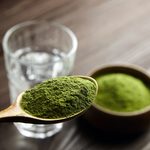The Goods on Asparagus
This member of the lily family was considered a delicacy by the Greeks and Romans for it’s great taste. but aparagus has more than that to offer. Packed with high power nutrients it’s definitely a green that’s worth getting to know.
At the Market
Seasonal Wisdom
Asparagus appears in Western markets as early as February with the first California crop. In the Midwest and East, the growing season lasts from May through July. Imported asparagus is sold in the fall and winter.
How to Make Your Pick
Good fresh asparagus has firm round spears with tightly closed tips of deep green or purple. Spears at least a half-inch in diameter tend to be more tender than smaller ones. Pick spears of uniform size, if you can, so that they will cook evenly.
In the Kitchen
Smart Storage
Asparagus should be eaten as soon as possible after being picked. Stored at room temperature, it can, for example, lose half its vitamin C in two days. If you must keep it overnight, wrap the bottom ends in damp paper towels, cover it with plastic wrap, and put it in the refrigerator. Or you can stand the spears upright in a glass of water in the refrigerator, covered with a plastic bag, for up to two days.
Prep Tips
To ready asparagus for cooking, wash it carefully to rid it of any sand. Snap off and discard the tough ends. If your asparagus has thick stalks, use a swivel-blade peeler to peel off the skin on the bottom of the remaining stem.
Pick Your Cooking Style
Classic Cuisine
Steaming or boiling are the traditional methods for cooking whole spears. It takes about 3 to 5 minutes to cook asparagus either way. Be careful not to overcook asparagus or it will become soggy and limp. In fact, you should remove asparagus from the heat when the spears are just tender-crisp because they will continue to cook as they cool.
Simple Shortcut
Microwaving is another easy way to cook asparagus spears: Place a pound of spears, tips to the center, in a shallow microwaveable dish, add 14 cup water, cover tightly and cook at 100 per cent power for 4 to 7 minutes.
Modern Methods
More recently, it has become popular to roast asparagus spears in the oven with a little olive oil and seasonings. Preheat the oven to 190°C. Lay the spears in a single layer in a shallow pan, spray with olive oil, and season with salt and pepper. Roast until spears are tender-crisp, about 20 minutes.
To grill asparagus, brush the spears with olive oil, sprinkle with salt, and place crosswise on the grill rack over a medium fire. Grill, turning often, until tender, 4 to 6 minutes, depending on the thickness of the spears. Sprinkle with pepper and lemon juice before serving. To make grilling easier and quicker, you can first parboil asparagus in a large pot of rapidly boiling, lightly salted water for just 1 minute. Drain and spread spears out to cool quickly and prevent further cooking. Then grill for just 3 to 4 minutes.
Perfect Placement and Presentation
Whole asparagus spears, served on their own, make an elegant first course or a special occasion side dish. The traditional sauce for hot asparagus spears is lemony, buttery hollandaise and for cold asparagus spears, vinaigrette or mayonnaise. Cut-up asparagus makes a good addition to stir-fries. Parboiled or stir-fried asparagus pieces are delicious in omelets, salads, soups, and stews.
Fresh Ideas
When it comes to flavor, asparagus can certainly stand on its own. But it also goes well with lemon or balsamic vinaigrette, mustard-mayonnaise dressing, ginger-flavoured soy sauce, or a topping of shaved Parmesan cheese.
A favorite party nibble for the low-carbohydrate crowd is low-fat ham slices rolled around short spears of cold cooked asparagus—with or without a dab of mayonnaise. Asparagus has a low glycogenic count.
Leftover cooked green asparagus, pureed in a food processor or blender, can be heated up with a little milk and a pinch each of chopped parsley and chopped tarragon to make an almost instant cream of asparagus soup.
Packed Into One Cup of Asparagus
- Less than 50 calories
- Two-thirds the daily requirement for the B vitamin folate, which helps new blood cells form and prevents serious birth defects
- Thiamine and other B vitamins necessary for energy metabolism
- More than one-fourth the daily requirement for vitamin C
- 4 grams of fiber
- A phytochemical called glutathione, one of the most potent antioxidants for fighting the cell destruction that leads to disease



